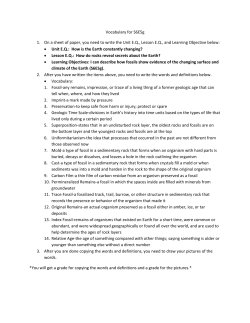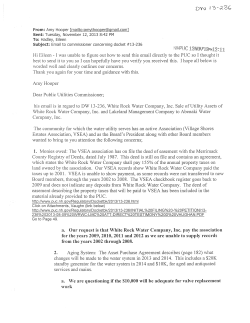
Earth Materials: Metamorphic Rocks
1 2 Earth Materials: Metamorphic Rocks • What is metamorphism Metamorphism • Agents of metamorphism Metamorphic rocks are formed from igneous rocks, p rocks through g byy sedimentaryy rocks,, or other metamorphic changes in pressure, changes in temperature, and/or the action of fluids. • Types of metamorphism • Foliation • Classification of metamorphic rocks • Metamorphic grade • The rock cycle 3 Causes/Agents of Metamorphism Pressure confining pressure (lithostatic pressure) -equal pressure in all directions - increased confining pressure can cause minerals with more compact (denser) structures to form directed pressure - pressure which is greater in a specific direction - may cause folding or cause mineral to grow with a specific orientation Temperature - different minerals are stable at different temperatures - changing the temperature can cause the types of minerals present in a rock to change Hydrothermal fluids (mostly water and/or carbon dioxide plus dissolved material) - can change the overall chemical composition of a rock by adding or removing material - many important ore deposits have been formed by this metamorphic process Two of the major types of metamorphism Regional Metamorphism Example with directed pressure (foliated rocks) Major Types of Metamorphism Regional metamorphism - the most wide-spread - occurs over very large areas - changes in pressure and temperature are the most important factors - commonly results from: - mountain building - with directed pressure - deep burial - lithostatic pressure only Contact metamorphism - occurs near the edges of igneous intrusions - the intensity of metamorphism is greatest close to the intrusion and less farther away - increased temperatures and hydrothermal fluids are the most important factors - the zone of contact metamorphism is called a contact aureole 5 Contact Metamorphism (non-foliated rocks) 4 6 Metamorphic textures Foliated metamorphic rocks - foliation refers to a preferred orientation of mineral grains found in some metamorphic rocks - metamorphic rocks which have a preferred orientation off mineral i l grains i are called ll d foliated f li t d metamorphic t hi rocks k - the preferred orientation is the result of directed pressure Non-foliated metamorphic rocks - lack a preferred orientation of mineral grains Fig 3.5 Understanding Earth 1 7 8 Common types of foliated metamorphic rocks slate • has slaty cleavage • dull • crystals too small to see phyllite • similar to slate but is shiny • crystals too small to see schist • has visible crystals • often composed primarily of micas Foliation in metamorphic rocks Note how some minerals are oriented perpendicular to the direction of maximum pressure gneiss • has visible crystals • has bands of different colors Fig 8.5 Understanding Earth 9 Slate 10 Schist with micas and large garnet crystals Schist composed of micas (mica schist) Fig 8.8 Understanding Earth Fig 8.10 Understanding Earth Geology - Chernicoff S. Kuehn 2005 11 12 Other metamorphic rocks Gneiss (composition of major importance for classification) Note the lighter and darker colored bands Typically non-foliated or weakly foliated: quartzite - composed primarily of quartz Geology - Chernicoff marble - composed mostly of calcite and/or dolomite Fig 8.8 Understanding Earth Typically non-foliated: hornfels - variable composition skarn - contains mostly calcite and/or dolomite with garnet 2 13 14 Quartzite, a type of nonfoliated metamorphic rock The parent rock is sandstone Other metamorphic rocks Fig 8.9 Understanding Earth mylonite - formed in the deepest parts of fault zones - a type of gneiss (so always foliated) migmatite - formed when a rock begins to partially melt - represents the transition between metamorphic and igneous rock Marble, a type of nonfoliated metamorphic rock The parent rock is limestone - usually foliated Fig 8.9 Understanding Earth 15 16 Migmatite The lighter-colored part of this rock represents a granite-like liquid produced by partial melting Geology - Chernicoff Mylonite Produced by shearing in the deepest parts of fault zones. Arrows indicate the shear direction in this sample Understanding Earth 17 Different degrees of metamorphism Original rock Metamorphic grade Low grade High grade (relatively little change) (much change) - greater pressures and greater temperatures correspond to higher grades of metamorphism Fig 8.2 Understanding Earth Modified from: Fig 8.7 Understanding Earth - refers to how much a rock has been changed by metamorphism 3 In contact metamorphism, the intensity (grade) decreases with distance from the source of heat (intrusion). 19 20 Rock Cycle exercise At different temperatures, different minerals form in the metamorphic auriole around the intrusion. A geologist studying the metamorphism could use the minerals like a thermometer. Fig 8.15 Understanding Earth 22 21 The rock cycle Fig 3.10 Understanding Earth Rocks, Minerals, and the Rock Cycle Rock cycle; Formation of igneous, sedimentary, and metamorphic rocks http://serc.carleton.edu/NAGTWorkshops/visualization/collections/rock_cycle.html Rock cycle http://www.rocksandminerals.com/rockcycle.htm Rocks, minerals, rock cycle, etc. http://www earth2class org/er/teachers/lessonplans/index php http://www.earth2class.org/er/teachers/lessonplans/index.php Rocks & minerals at Volcano World http://volcano.oregonstate.edu/education/vwlessons/lessons/lesson4.html Rock identification (ppt) http://www.gc.maricopa.edu/earthsci/imagearchive/rock_identification.htm Resources for teachers http://www.dlese.org/dds/query.do?q=rock&s=0 4
© Copyright 2025












